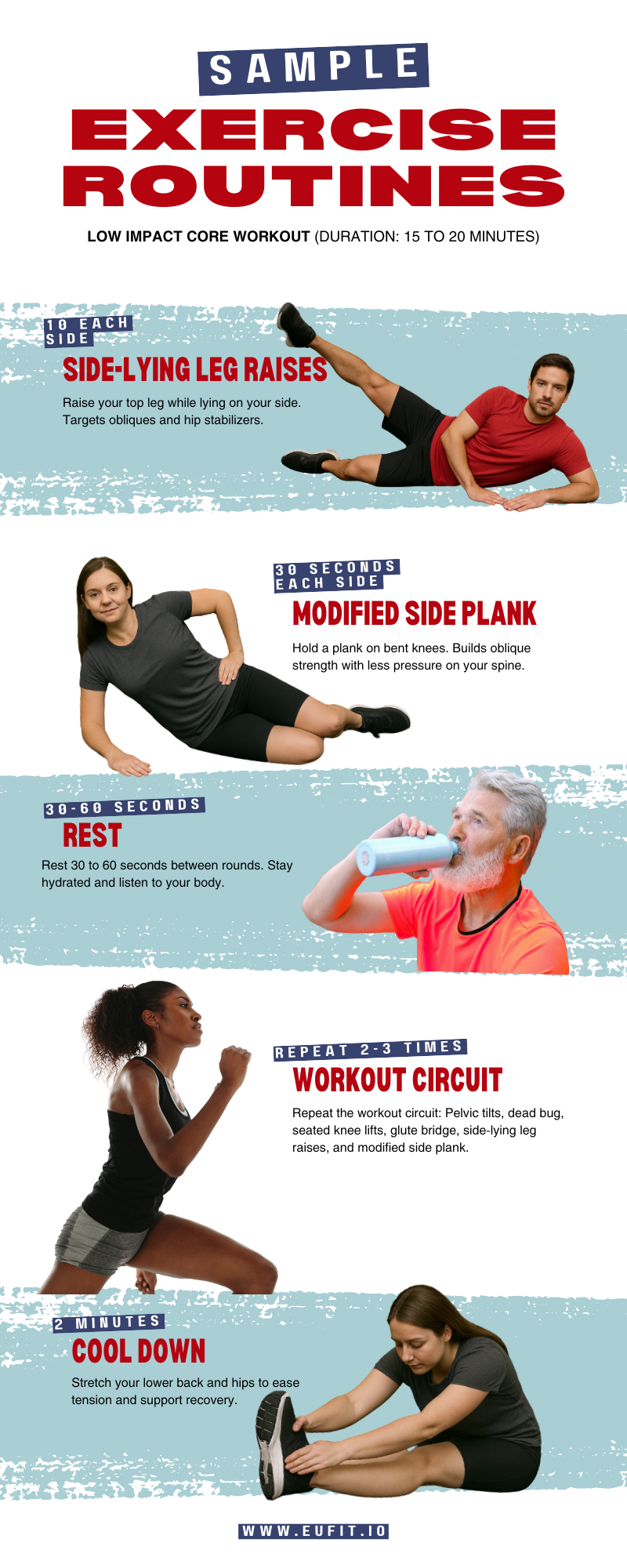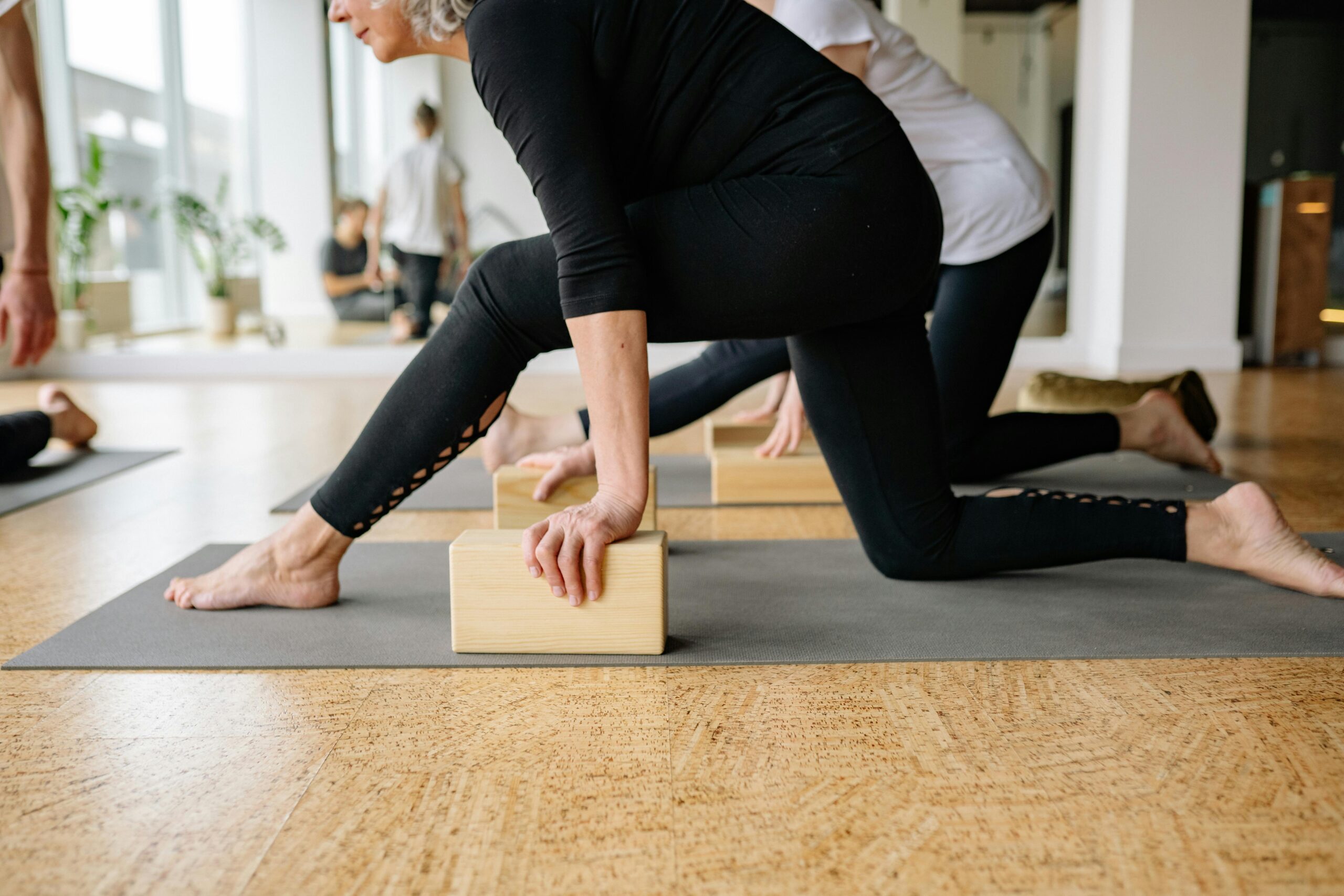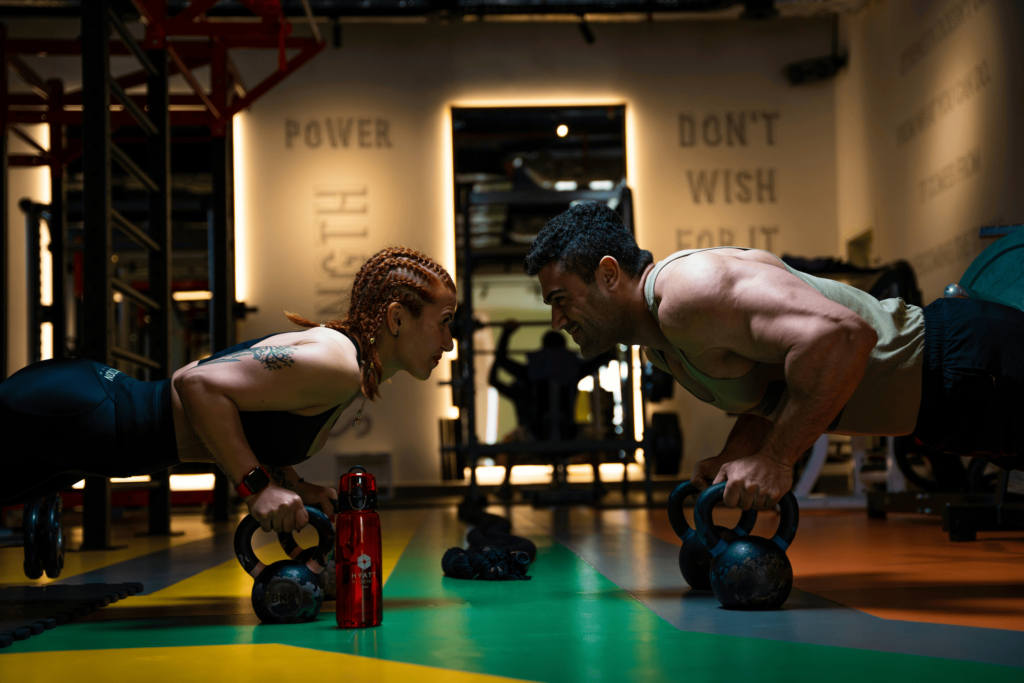When we hear “core workout,” we often imagine endless crunches, minute-long planks, or intense routines that leave our lower backs screaming for mercy. But what if you could strengthen your core with low impact exercises?
Yes, it is possible to strengthen your core without all the strain. We introduce: low impact core exercises. These core exercises are gentle on the joints, perfect for beginners, and surprisingly powerful for building real, functional strength.
Whether you are recovering from injury, easing into fitness, or simply looking for a more sustainable way to strengthen core muscles, this guide has your back (and abs).
What are Low Impact Core Exercises?
Low impact core exercises are movements designed to build strength without putting stress on your joints. They typically avoid jumping, excessive twisting, or spinal strain. Instead, they focus on control, stability, and precise form.
These are ideal for:
- Beginners starting their fitness journey
- Those with joint pain or injuries
- Pregnant or postpartum individuals
- Anyone seeking an effective but gentle core workout at home
Why Focusing on Core Strength Matters?
Your core isn’t just about abs. It is a powerful network of muscles: your oblique, hips, lower back, and glutes. All working together to support movement, stability, and posture.
Strengthening these muscles can:
- Improve posture and reduce back pain
- Enhance balance and coordination
- Make everyday movements (like lifting, walking, or even sitting) more efficient
- Prevent injury during workouts and daily tasks
The best part about core strength is that it doesn’t require high-intensity exercises or fancy gym equipment.
Benefits of Low Impact Core Workouts
Whether you are new to fitness or simply want to give your joints a break, low impact core exercises are your best bet. They offer all the core-strengthening goodness without the jumping, straining, or fast-paced intensity that can leave you feeling wrecked instead of refreshed.
Here’s why these low impact core exercises are so popular, and why they might be exactly what you need right now:
1. Low impact core workouts are joint-friendly.
Low impact means less stress on your knees, wrists, hips, and spine. These exercises use controlled movements, not explosive ones, making them a great choice for those with previous injuries, arthritis, or anyone who is not keen on high-impact pounding.
Think of it as strength training that’s gentle, yet seriously effective.
2. Beginner-friendly and inclusive exercises.
New to workouts? No problem.
These exercises are designed to meet you where you are. Whether you are just starting out, returning after a long break, or easing back in after pregnancy or injury.
They are easy to follow, simple to modify, and flexible enough for all fitness levels. Everyone deserves a strong core, and this is one of the most accessible ways to build it.
3. Minimal equipment needed.
Forget the gym membership or fancy machines. Most low impact core workouts require just your bodyweight, a mat, and maybe a cushion for extra support.
This means you can start right now, in your bedroom or living room. No setup stress or gear needed.
4. Quick and time-efficient workout routine.
Short on time? You can squeeze in a solid session in just 15 to 20 minutes. Even a single round of three to four moves can get your core fired up and working.
It is perfect for quick morning workouts, lunch breaks, or winding down at the end of the day. No more excuses.
5. Sustainable and burnout-free.
Because they are easy on the body and mentally manageable, low impact workouts are something you can actually stick with, week after week, month after month.
You are not pushing yourself to the brink, you are building a habit that lasts. The kind of habit that strengthens you over time, without the crash-and-burn cycle.
6. Improves everyday functionality.
A strong core isn’t just for workouts. It supports better posture, easier movement, and fewer aches during everyday activities like lifting groceries, walking, or even sitting at your desk.
These exercises improve functional strength, meaning you are not just getting fitter. You are making your life easier.
7. Gentle but still challenging.
Don’t mistake “low impact” for “low effort.” These workouts are still legit. They challenge your deep core muscles, improve coordination, and demand balance and control. All without leaving you breathless or sore for days.
It’s all about working smarter, not harder.
8 Best Low Impact Core Exercises You Can Do at Home
These low impact core exercises can be done in your living room with just a mat. Here is a beginner-friendly lineup of effective core moves:
1. Pelvic Tilts
- How to do it: Lie on your back, knees bent, feet flat. Gently tilt your pelvis to press your lower back into the mat. Hold for 5 seconds, then release.
- Reps: 10–12
- Benefits: Targets deep abdominals; great for postpartum recovery and back pain relief.
2. Dead Bug
- How to do it: Lie on your back with arms extended and knees at 90°. Slowly lower the opposite arm and leg toward the floor. Return and repeat on the other side.
- Reps: 10 each side
- Benefits: Builds core coordination and stability without joint impact.
3. Bird-Dog
- How to do it: Extend your right arm and left leg from all fours. Keep hips level. Hold, then return and switch sides.
- Reps: 8–10 on each side
- Benefits: Strengthens the full core and improves balance.
4. Glute Bridge
- How to do it: Lie down with knees bent. Press through your heels to lift your hips, forming a straight line from shoulders to knees.
- Reps: 15
- Benefits: Works the glutes, lower back, and core with zero jumping involved.
5. Seated Knee Lifts
- How to do it: Sit upright with your hands behind you for support. Slowly lift one knee to your chest, then switch.
- Reps: 12 each leg
- Benefits: Great for absolute beginners or anyone needing a chair-supported option.
6. Side-Lying Leg Raises
- How to do it: Lie on your side and slowly lift your top leg, then lower it with control.
- Reps: 10 each side
- Benefits: Targets obliques and hips while being super gentle on the spine.
7. Toe Taps
- How to do it: Start on your back with legs raised and knees bent. Lower one foot to tap the floor, then return and switch sides.
- Reps: 10 each side
- Benefits: Strengthens lower abs with minimal strain.
8. Modified Side Plank
- How to do it: Lie on your side with knees bent. Elbow under the shoulder. Lift your hips to form a straight line from shoulder to knees.
- Hold: 10–30 seconds on each side
- Benefits: Activates obliques and shoulder muscles, minus the usual plank struggle.
Sample Routine: Low Impact Core Workout
A proper workout structure is essential for every session. It helps you efficiently perform all the exercises and avoid improper execution of each exercise, preventing injury.
The most important thing to do in every workout is to start with a light warm-up: gentle stretches, arm circles, or a minute walk in place. To guide you better, here is a sample routine for you to follow:


Note: Repeat the circuit (all six exercises) two to three times, with 30 to 60 seconds interval in between for rest and recovery. Don’t forget to hydrate during exercises!
Tips to Stay Safe and See Progress in Low Impact Exercises
Getting stronger does not have to mean pushing yourself to the edge. Especially when it comes to low impact core exercises, the key to results lies in how you move, how often you move, and how you treat your body in the process.
Here’s how to make your workouts stay effective, safe, and sustainable.
1. Prioritize form over reps.
When it comes to core work, form is everything. It is not about how many reps you can crank out. It’s about how well you engage the right muscles with each movement.
Take your time with each exercise. Slow, controlled movements help activate the deep abdominal muscles and protect your spine. Rushing through reps with poor form will not only sabotage your progress but could also lead to injury.
Pro Tip: Record yourself or use a mirror to check your alignment, especially for moves like bird-dogs or glute bridges.
2. Breathe intentionally.
It might sound basic, but proper breathing is a game-changer in core workouts. A common mistake is holding your breath during the hard parts. Not only does this limit your endurance, it can also increase tension in your neck and back.
Instead, try this:
- Exhale as you contract or exert (e.g., when lifting or crunching).
- Inhale as you release or return to the starting position.
This rhythm supports better oxygen flow, stronger core engagement, and more control throughout the movement.
3. Listen to your body (seriously!)
Your body is smart, and it speaks up when something isn’t right. If you feel sharp pain, dizziness, or anything that feels “off,” pause immediately.
It is perfectly okay to modify exercises. If you can’t hold a plank for 30 seconds, do it on your knees. If you need more support during your leg raises, slide a pillow under your lower back.
Pain is a red flag. Soreness is okay, but joint pain or discomfort in your lower back is a sign to adjust.
4. Stay consistent, not perfect.
Results come from showing up regularly, not from going all-out every time. You don’t need to workout every single day to see progress.
In fact, two to three core sessions a week are more than enough to build strength and stamina, especially when you are just starting out.
The key is momentum. The more consistent your routine, the more your body adapts, improves, and rewards you with better posture, less back pain, and stronger movement patterns.
Remember: consistency > intensity.
5. Scale gradually.
If you feel stronger, that’s your green light to level up, but do it smartly.
Small tweaks go a long way in low impact workouts:
- Add extra reps or longer holds
- Include light ankle or wrist weights
- Combine exercises into longer circuits
- Reduce rest time gradually
Progress does not have to mean “more pain.” It just means a little more challenge on your terms, at your pace.
6. Don’t skip recovery.
Muscles grow and strengthen between workouts, not just during them. So be kind to your body by allowing time for recovery. Gentle stretching, mobility work, or simply taking a day off are all part of an effective training plan.
If you feel sore after a workout, that’s normal. But if you feel worn out all week, that’s a cue to slow down, hydrate, sleep, and reset.
Wrapping Everything Up
Low impact core exercises prove that you don’t need high-intensity routines to see real strength gains. Whether you are just beginning, bouncing back after a break, or wanting something gentle yet effective. These workouts are a smart, sustainable way to strengthen your core muscles.
The best part is that you can perform all of these workouts in the comfort of your home. No noise, no stress, no gym required. Just you, your mat, and a little bit of fitness motivation.
Remember to start where you are. There is no need to compare with others. Use what you currently have, and keep consistent in your program. One rep at a time. You’ve got this.


